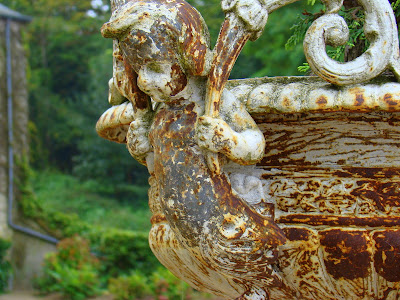
Entering the Chateau Grounds.

Entering the Chateau Grounds. Beautiful!

The Impressive Driveway, No Cars Allowed.

The Chateau!

Entrance Statue, Chateau Chenonceau.

Chateau Chenonceau.

Inside, Entrance to Chanteau Chenonceau.

Diane de Poitiers

Flowers.

The scuttling of many feet over the centuries has taken its toll on the beautiful tile floors. Vestiges of its decoration are visible only around the edges of the Guard's room.

The Chapel inside the Chateau.

I think this room was called the Gallery.

The Gallery.

The Bread Oven.

Pots and Pans.

The Stove!

Where the Servants Ate.

I Just Loved These Flower Arrangements, They had Them in Every Room of the Chateau.

More Flowers.

Looking out from the Chateau.

One of the Many Beautiful Buildings on The Chateau's Grounds, this one was right Beside the Gardens.

Gardens.

Gardens, Chateau Chenonceau.
One of the most visited castles in France, Chateau Chenonceau is a Renaissance chef d'oeuvre that stands firmly in the river Cher. One of a garland of Loire Valley castellar beauties, Chenonceau is most known for the influential women who held sway here, giving it the sobriquet
Chateau des Dames (Ladies Castle). It was built in 1513 by Katherine Briconnent, then made even more attractive by Diane de Poitiers and Catherine de Medicis, and saved from the rigours of the French Revolution by Mrs. Dupin.
The enchanting castle may be smaller in comparison to others, but what it lacks in size it makes up for in charm. Throughout its interior there is an arresting array of tapestries, paintings, ceilings, floors, fireplaces and furniture on show. The chateau's exquisite surroundings include 70 hectares of forest park, stables, an intricate hedge maze, several immaculate gardens and a wax museum which shows all the women who built Chenonceau as well as a sumptuous collection of costumes.
The many gardens are ornamented with a myriad of shrubs, hedges and hundreds of climbing and stemmed roses. There are over 4000 flowers grown on the castle grounds, which are planted twice a year in spring and summer. In the summer months, visitors can even rent paddle boats at the castle to ride down the Cher river.
My favourite part of the whole Chateau were all the fabulous bouquets of fresh flowers. Each room of the Chateau was adorned with a truely original floral composition prepared by the Chateau's own team of florists. The flowers are grown in a garden strictly reserved for putting together these fabulous flower arrangements - the bouquets are renewed twice a week.























































